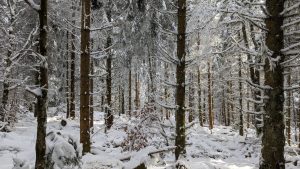Forests in a Changing Climate
To care for the woods is to witness all:
nature unfolds, the seasons pass.
George Nakashima, Architect
Forests provide shade, which helps lower local temperatures. They also increase air humidity and play an important role in preventing soil erosion.


When it comes to climate protection, forests are among the most powerful natural allies: they can absorb and store vast amounts of carbon dioxide (CO₂), reducing greenhouse gas levels in the atmosphere.
However, not all forests are equally effective in this role. Biodiversity is key. A diverse forest ecosystem is more resilient to change and can store more carbon in the long term. By contrast, monocultures are vulnerable to pests and diseases – as seen with the devastating spread of the bark beetle in Central Europe. #Borkenkäfer.
That is why protecting forests and managing them sustainably is essential to maximize their positive impact on the climate.

Yet climate change itself puts forests under severe stress: since 2018, more than 400,000 hectares of forest in Germany have died due to drought and pest infestation. One thing is clear: forests must be prepared for the challenges of the coming decades. But what will the forest of the future look like? Will traditional species such as beech, oak, pine, and spruce still dominate? Or will today’s “exotic” tree species take their place?
Research Questions
In the ForschungRegion, the Thünen Institute is investigating the effects of heatwaves on the forests in the Harz.
Regarding research and questions:
